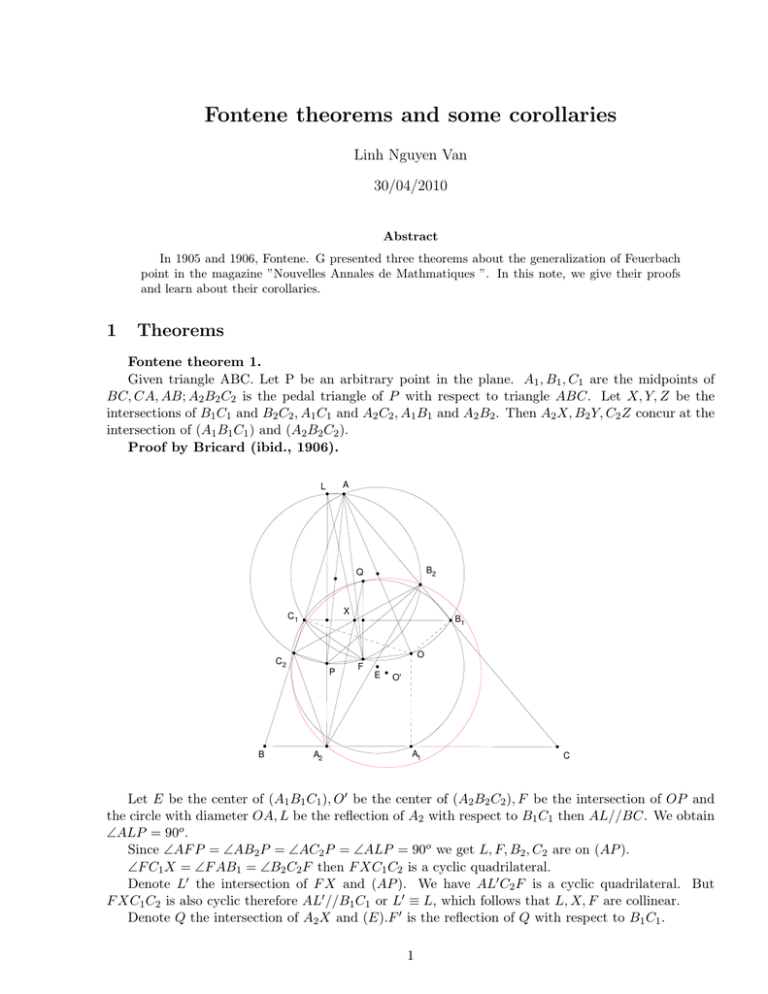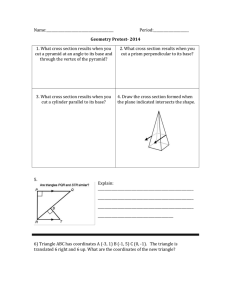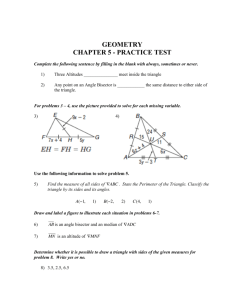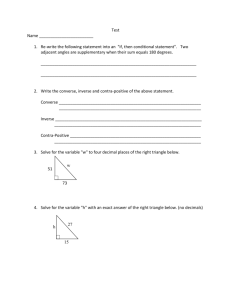Fontene theorems and some corollaries Linh Nguyen Van 30/04/2010
advertisement

Fontene theorems and some corollaries
Linh Nguyen Van
30/04/2010
Abstract
In 1905 and 1906, Fontene. G presented three theorems about the generalization of Feuerbach
point in the magazine ”Nouvelles Annales de Mathmatiques ”. In this note, we give their proofs
and learn about their corollaries.
1
Theorems
Fontene theorem 1.
Given triangle ABC. Let P be an arbitrary point in the plane. A1 , B1 , C1 are the midpoints of
BC, CA, AB; A2 B2 C2 is the pedal triangle of P with respect to triangle ABC. Let X, Y, Z be the
intersections of B1 C1 and B2 C2 , A1 C1 and A2 C2 , A1 B1 and A2 B2 . Then A2 X, B2 Y, C2 Z concur at the
intersection of (A1 B1 C1 ) and (A2 B2 C2 ).
Proof by Bricard (ibid., 1906).
A
L
B2
Q
X
C1
B1
O
C2
P
B
A2
F
E
O'
A1
C
Let E be the center of (A1 B1 C1 ), O0 be the center of (A2 B2 C2 ), F be the intersection of OP and
the circle with diameter OA, L be the reflection of A2 with respect to B1 C1 then AL//BC. We obtain
∠ALP = 90o .
Since ∠AF P = ∠AB2 P = ∠AC2 P = ∠ALP = 90o we get L, F, B2 , C2 are on (AP ).
∠F C1 X = ∠F AB1 = ∠B2 C2 F then F XC1 C2 is a cyclic quadrilateral.
Denote L0 the intersection of F X and (AP ). We have AL0 C2 F is a cyclic quadrilateral. But
F XC1 C2 is also cyclic therefore AL0 //B1 C1 or L0 ≡ L, which follows that L, X, F are collinear.
Denote Q the intersection of A2 X and (E).F 0 is the reflection of Q with respect to B1 C1 .
1
Consider the Symmetry SB1 C1 : (AO) 7→ (E), but Q ∈ (E) hence F 0 ∈ (AO).
On the other side, SB1 C1 maps A2 to L. Furthermore A2 , X, Q are collinear so L, X, F 0 are collinear,
which is equivalent to F 0 ≡ F .
We deduce that A2 LQF is a isosceles trapezoid.
This means XQ.XA2 = XL.XF = XB2 .XC2 .
Therefore Q lies on (O0 ). Similarly B2 Y, C2 Z also pass through Q. We are done.
Fontene theorem 2.
If a point P moves on the fixed line d which passes through the circumcenter O of triangle ABC
then the pedal circle of P with respect to triangle ABC intersects the Nine-point circle of triangle
ABC at a fixed point.
Proof.
According to the proof of Fontene theorem 1, the point of contact Q of (E) and (O0 ) is the reflection of a point F which lies on OP with respect to the line B1 C1 . It is easy to show that O is the
orthocenter of triangle A1 B1 C1 thus Q is the Anti-Steiner point of d. Therefore Q is fixed. Our proof
is completed.
Fontene theorem 3.
Denote the isogonal conjugate of P with respect to triangle ABC as P 0 . Then the pedal circle of
P is tangent to the Nine-point circle of triangle ABC if and only if O, P, P 0 are collinear.
Proof.
According to Fontene theorem 2 we can prove that the second intersection Q0 of (O0 ) and (E) is
the Anti-Steiner point of OP 0 . This means Q0 ≡ Q if and only if OP ≡ OP 0 or O, P, P 0 are collinear.
We are done.
Note. Feuerbach point is a corollary of Fontene theorem 3, when P coincides with the incenter or 3
excenters.
2
Some corollaries
Corollary 1. O0 is the orthocenter of triangle XY Z.
Proof. In fact, applying Fontene theorem 1 we claim A2 X, B2 Y, C2 Z concur at a point Q which
lies on (O0 ), which implies that XZ is the polar of Y with respect to (O0 ), XY is the polar of Z with
respect to (O0 ). Therefore O0 is the orthocenter of triangle XY Z.
Corollary 2. Denote A3 B3 C3 the pedal triangle of the isogonal conjugate P 0 of P with respect to
triangle ABC. Then the Simson line of Q with respect to triangle A3 B3 C3 is parallel to the Simson
line of Q with respect to triangle A1 B1 C1 .
Proof.
2
L
A
Q
B2
X
C1
S
B1
T
C3
B3
R
O
C2
P'
F
P
A1
B
A2
A3
C
W
Let R, S be the projections of Q on B3 C3 , A3 B3 . Extend QR to W which lies on (O0 ), AF ∩ QW =
{T }. Since ∠QRS = ∠QB3 S = ∠QW A3 we deduce that RS//A3 W .
Moreover, ∠P 0 C3 B3 = ∠P 0 AB3 = ∠P AB hence AP ⊥ B3 C3 , which implies that AP//QW .
This means ∠T W A3 + ∠F T W = ∠QA2 A3 + ∠P AF = ∠QA2 A3 + ∠P LF = ∠QA2 A3 + ∠P A2 Q =
90o . So SR//A3 W//OP.(1)
According to the proof of Fontene theorem 2, Q is the Anti-Steiner point of OP with respect to
triangle A1 B1 C1 so the Simson line of Q with respect to triangle A1 B1 C1 is parallel to OP.(2)
From (1) and (2) we are done.
Corollary 3. Given triangle ABC with its circumcircle (O) and its orthocenter H. Let N be the
Nagel point of triangle ABC. ON meets (O) at Q. Then the Simson line of Q with respect to triangle
ABC is parallel to N H.
Proof.
First let us introduce a lemma:
Lemma 1. Let I, G, N be the incenter, centroid and Nagel point of triangle ABC, respectively.
Then I, G, N are collinear and IN = 3IG.
Proof.
3
A
T
Y
B'
Y'
I
G
N
C
R
B
X'
A'
X
K
P
Ia
Let X, Y be the tangencies of (I) with BC, AC. XI cuts (I) at T . We will show that A, T, N are
collinear.
IY
IA
IT
=
=
,
In fact, let Ia be the A-excenter. (Ia ) contacts BC, AC at X 0 , K. We have
0
Ia X
Ia K
Ia A
0
which follows that A, T, X are collinear or A, T, N are collinear.
Let P be a point on AI such that I is the midpoint of AP . Let B 0 be the midpoint of AC. IY
intersects (I) at R, BR intersects AC at Y 0 . Because IB 0 is the midline of two triangles Y RY 0 and AP C
at the same time hence BN//IB 0 //P C 0 . Likewise, CN//BP . Therefore BN CP is a parallelogram.
We conclude that A0 is the midpoint of N P .
GA
Let G0 be the intersection of AA0 and IN . Since IA0 is the midline of triangle AP N then
=
GA0
GI
= 2. Our lemma is solved.
GN
Back to our problem.
4
C'
A
B'
O
I G
N
H
B
C
P
A'
Through A, B, C construct three lines which are parallel to opposite side, they intersect each other
and make triangle A0 B 0 C 0 . We have (ABC) is the Nine-point circle of triangle A0 B 0 C 0 .
Consider the homothetic H−2 : (ABC) 7→ (A0 B 0 C 0 ), O 7→ H, I 7→ N . But O is the center of (ABC)
so H is the center of (A0 B 0 C 0 ), I is the incenter of triangle ABC so N is the incenter of triangle A0 B 0 C 0 .
We get P is the Feuerbach point of triangle A0 B 0 C 0 . According to the proof of Fontene theorem 2 , P
is the Anti-Steiner point of N H with respect to triangle ABC. This means the Simson line of P with
respect to triangle ABC is parallel to N H.
Corollary 4. Given triangle ABC with its circumcenter O. Let l be a line which passes through O.
l intersects BC, CA, AB at X, Y, Z, repspectively. Then four circles (AX), (BY ), (CZ), the Nine-point
circle of triangle ABC are concurrent.
Proof. In fact, the result follows immediately from Fontene theorem 2 because X, Y, Z are three
special cases of P on the line l.
Corollary 5. Given triangle ABC.P is an arbitrary point in the plane. A1 B1 C1 is the pedal
triangle of P with respect to ∆ABC. A2 , B2 , C2 are the midpoints of BC, CA, AB, respectively.
A3 , B3 , C3 are the reflections of A1 , B1 , C1 with respect to A2 , B2 , C2 , respectively. Then three circles (A1 B1 C1 ), (A2 B2 C2 ), (A3 B3 C3 ) are concurrent.
Proof.
5
A
C3
Y
C2
C1
B1
Q
B2
P
O
B3
E
B
A2
A1
A3
C
Since A1 B1 C1 is the pedal triangle of P with respect to triangle ABC then applying Carnot theorem
we obtain:
BA21 − CA21 + CB12 − AB12 + AC12 − BC12 = 0.
Hence CA23 − BA23 + BC32 − AC32 + AB32 − CB32 = 0.
We deduce that A3 B3 C3 is the pedal triangle of Q with respect to triangle ABC.
Applying Thales theorem, it is easy to see that the perpendicular bisector of the line segment BC
passes through the midpoint of P Q. Similarly we get the circumcenter O of triangle ABC is the
midpoint of P Q.
Denote Y the Anti-Steiner point of OP with respect to triangle A2 B2 C2 then according to the
proof of Fontene theorem 2, Y ∈ (A1 B1 C1 ). Moreover O, P, Q are collinear so Y is the Anti-Steiner
point of OQ with respect to triangle A2 B2 C2 . But A3 B3 C3 is the pedal triangle of Q with respect to
triangle ABC thus according to the proof of Fontene theorem 2 again, Y ∈ (A3 B3 C3 ). We are done.
Corollary 6. Given triangle ABC. Let A1 be the projection of A on BC, A2 , B2 , C2 be the
midpoints of BC, CA, AB, respectively. P is an arbitrary point in the plane, A0 B 0 C 0 is the pedal
triangle of P with respect to ∆ABC.(A0 B 0 C 0 ) ∩ (A2 B2 C2 ) = {F, F 0 }. A line through A0 and parallel
to AP meets AA1 at A00 . Then (A0 A00 ) passes through one of two points F, F 0 .
Proof.
6
A
A''
I'
V
M
C2
L
B2
N
C'
I
E
S
F
B'
P
B
A1
A2
A'
C
Let V be the intersection of B 0 C 0 and B2 C2 . According to Fontene theorem 1 we get A0 , V, F are
collinear.
On the other side, denote I 0 , L the midpoints of AP, AA0 , respectively.
Since AA00 A0 P is a parallelogram we claim I, L, I 0 are collinear and II 0 ⊥ BC. But L ∈ B2 C2
we deduce that I 0 is the reflection of I with respect to B2 C2 . Therefore (I 0 , I 0 A) is the reflections of
(I, IA00 ) with respect to B2 C2 . This means the intersections M, N of two circles lies on B2 C2 .
Moreover B 0 , C 0 ∈ (I 0 , I 0 A) hence V F .V A0 = V B 0 .V C 0 = V M .V N , which follows that F, A0 , M, N
are concyclic or (I, IA00 ) passes through F .
Corollary 7. Given triangle ABC. Let P be an arbitrary point in the plane, A1 B1 C1 be the
pedal triangle of P with respect to ∆ABC. Denote the radius of(A1 B1 C1 ) as R. P 0 is the isogonal
conjugate of P with respect to ∆ABC. Rays A1 P, B1 P, C1 P cut (P 0 , 2R) at X, Y, Z, respectively. Then
AX, BY, CZ concur at a point on (P 0 , 2R).
Proof.
7
A3
X
A
B2
T
B1
C2
P''
C1
P'
P
O
E
B
A1
C
L
A2
B3
A4
H
C3
Let A2 , B2 , C2 be the reflections of P with respect to BC, CA, AB. Since the center O of (A1 B1 C1 )
is the midpoint of P P 0 then OA1 is the midline of triangle P P 0 A2 . This means P 0 A2 = 2R or A2 ∈ (P 0 ).
Similarly, B2 , C2 ∈ (P 0 ).
Consider the homothetic HP2 : A1 7→ A2 , B1 7→ B2 , C1 7→ C2 , A 7→ A3 , B 7→ B2 , C 7→ C2 so (P 0 , 2R)
is the image of (O, R) under HP2 and (P 0 ) is the pedal circle of P with respect to ∆A3 B3 C3 .
Let P 00 be the reflection of P with respect to P 0 , A4 be the projection of P 00 on B3 C3 then A4 ∈ (P 0 ).
Let H be the reflection of A4 on B3 C3 , T be a point on A3 H such that A3 T = P 00 A3 . According to
corollary 6, (A4 T ) passes through the intersection L of the Nine-point circle of triangle A3 B3 C3 and
(P 0 ), which implies that T L ⊥ A4 L.
On the other side, ray A1 P intersects (P 0 ) at X thus XA4 is the diameter of (P 0 ) , we conclude
that XL ⊥ A4 L.
Therefore L, T, X are collinear.
Moreover P X// = P 00 A4 // = A3 T we obtain A3 XP T is a parallelogram. But A is the midpoint
of P A3 hence T, A, X are collinear.
This means L ∈ AX . Likewise, BY, CZ also pass through L. Our proof is completed.
8
References
[1] Roger A.Johnson, Advanced Euclidean geometry, Dover reprint, 1960.
[2] Fontene Theorems, from Wolfram Mathwold
http://mathworld.wolfram.com/FonteneTheorems.html
[3] tdl, Mathlinks topic 173756 (Griffiths’ Theorem)
http://www.mathlinks.ro/viewtopic.php?t=173756
[4] Leonhard Euler, Mathlinks topic 290991 (Simson line wrt pedal triangle)
http://www.mathlinks.ro/viewtopic.php?t=290991
[5] Buratinogigle, Mathlinks topic 302763 (5 circles concurrent)
http://www.mathlinks.ro/viewtopic.php?t=302763
[6] jaiawaj, Mathlinks topic 292717 (Nagel Simson)
http://www.mathlinks.ro/viewtopic.php?t=292717
[7] Buratinogigle, Mathlinks topic 325489 (Intersect on circle)
http://www.mathlinks.ro/viewtopic.php?t=325489
[8] Livetolove212, Mathlinks topic 316265 (A property of Fontene’s theorem)
http://www.mathlinks.ro/viewtopic.php?t=316265
Linh Nguyen Van: Highshool for gifted student, Hanoi University of Science, Vietnam.
Email address: lovemathforever@gmail.com
9






